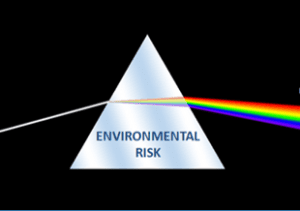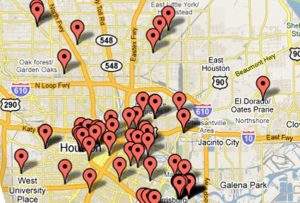NOTE TO READERS: This article was just published in the January 2017 Edition of the Environmental Bankers Association’s Journal, and appears here with permission from the publisher. Links to the full Journal containing timely articles related to lender property risk management are provided after this article.

PAST: The “Good Old Days” of Data Collection
Ask any veteran environmental professional what it was like doing a Phase I environmental site assessment in the early 1990s, and chances are you will get an earful about how difficult it was to access government data on property contamination. Back then, data collection was no easy feat. Recordkeeping by government agencies was not widespread, records took a long time to find and access, updates were infrequent and the data was inconsistent. All of this added up to a time-consuming and inefficient record collection process. Consider a few elements of doing a Phase I ESA in 1993 that might shock our coworkers of younger generations today:
- Sorting through regulatory records, like the CERCLIS list, by zip code.
- Mailing a FOIA request then waiting for records to be mailed back to your office.
- Taping pictures to pages and typing in descriptions.
- Sending film away and waiting days for site photos to be developed.
- Printing and binding reports, then mailing them to the client.
The early 1990s marked a turning point as the industry evolved away from the “Wild West Days” of Phase I ESAs. In 1993, the FDIC issued the first guidance for banks in establishing an environmental risk management policy. That year also brought the first ASTM Phase I ESA standard and Transaction Screen standard (ASTM E 1527- 93 and E 1528-97, respectively). Nearly a decade later, the Brownfields Amendments in 2002 gave rise to the development of the first federal rule for All Appropriate Inquiries, outlining the ten steps a prospective purchaser must complete to qualify for CERCLA liability protection. The federal rule was then adopted by agencies like the U.S. Small Business Administration and others in their own environmental due diligence guidance.

As a result of more standards, guidance and rules, lenders’ environmental risk policies became more sophisticated as more properties were viewed through the lens of environmental risk. Over time, the old decision-making process of “Phase I ESA-or no Phase I ESA?” based solely on loan size was replaced with tiered policies based on whether a property’s current or past use was a high-risk operation (e.g., gas station, dry cleaner, etc.), the location (urban vs. rural), property type and other site-specific considerations.
PRESENT: Efficiency is the Name of the Game
Today, the industry has evolved toward a standardized process for environmental risk management. And there is more of everything—more guidance, more property records, more technology tools, and of course, more pressure to process it all.
Technological Game Changers
Technological advances have reshaped how environmental due diligence is conducted. If you look back over the past twenty years, there were three game changers that revolutionized the industry:
1. Online Records

As more government agencies moved their record-keeping online, access to property risk information became much more efficient. This minimized, and even reduced, the need to conduct physical reviews of records in a library or government office, or mailing requests to regulators and waiting for the U.S. mail to arrive at the office with records. As a society, we have collected more data in the past five years than in all the rest of our history on Earth. Likewise, in our industry, there has been an enormous proliferation of property data records online since its birth in 1993, and the ability to access those records more quickly has had a significant impact on the practice.
2. Geocoding

It wasn’t enough to have government agencies building their own systems to house property data and making it publicly accessible electronically vs. on paper or even microfiche. The industry needed geocoding, that last step of connecting the dots between government data mapping technology to allow for converting an address to geographic coordinates (lat-lon). The ability to obtain records like aerial photos, city directories and myriad government records at the property level from an outside provider replaced having to go to local offices or libraries. Today, there is virtually no community in the U.S. that does not have some record of property contamination accessible in electronic format. Dramatic advances in mapping technology allow for accessing and viewing property risk data in more meaningful ways than ever before. These two advances allowed EPs to let go of some of the archaic practices of data collection and reporting, and move the industry down a path of interactive maps, and living-breathing documents rather than static ones.
3. Digital photos
Digital photography was the third major game changer for environmental risk management. The EPs in the field are the record keepers, the observers, the eyes on the property so the development of digital cameras revolutionized site visits. Now, not only do EPs have instantaneous site photos, but also the ability to crop images, zoom in, annotate them and incorporate these images easily into reports.
THE FUTURE
What advances are ahead that will be viewed in retrospect as the next round of game changers? Some are fun to think about. What would it be like to conduct collaborative virtual site visits with real time satellite imagery? Or using artificial intelligence for report writing algorithms? Or augmented reality to overlay virtual information on a picture of the real world on your phone?
Mapping technology holds significant promise for making it easy to highlight environmental issues on a property—or even across an entire portfolio of 100s or even 1000s of sites. Imagine a unified system that could store all types of underwriting data (structural, energy, appraisal, EHS compliance, environmental due diligence, etc.) together, way beyond anything available today. And then imagine if that system could auto-populate fields using live feeds from government agencies or the field. The possibilities truly are endless. In addition to improving data collection, and freeing up resources that would allow for deeper analysis of the data, it also opens the door for being able to more holistically analyze an entire group of properties using endless combinations of parameters. For instance, a user could run a report portfolio-wide and identify where the issues are across thousands of properties if a regulation changed or a legal issue arose.
Technology has made, and will continue to make, important leaps not just in how property risk data is collected and analyzed, but also how it is shared and experienced among EPs, lenders and other risk management professionals. Consider that the next stage of the industry’s evolution will continue the trend of flipping the time spent on data collection/report writing versus analysis. Advances are moving risk management professionals out of data collection mode as more data is available, and in more meaningful ways, at their fingertips. CIO Insight just released a study that estimated that 34 percent of workers spend an average of 1-2 hours a day on work that can be automated, which adds up to as much as 10 hours a week. The firms that streamline their internal operations and provide collaborative, easy-to-use technologies that enable employees to spend more time on meaningful and impactful tasks, and far less time on the repetitive and mundane ones, will have an advantage.
It truly is an exciting time for our industry, and you need only go back to the early 1990s to see why. Environmental risk management has moved by leaps and bounds already, but the pace of technology is accelerating so the changes we will see in the next 23 years, or by 2039, is mind-boggling. The technologies that have already taken root will continue to improve and it is critical for firms to be open to this growth. Tomorrow’s challenge is learning how to be successful in a world that demands adaptability and creativity.
FOR MORE INFORMATION

To read this article and others, the EBA Winter Journal is here in its entirety, containing other articles by noted subject matter experts, including:
- Vapor Intrusion Litigation Lessons
- Flint Inspires Renewed Vigilance for Lead in Drinking Water
- Case Study: Environmental Liability Transfers
- Perfluorinated Chemicals: An Emerging Contaminant
More information on joining EBA is available here.
